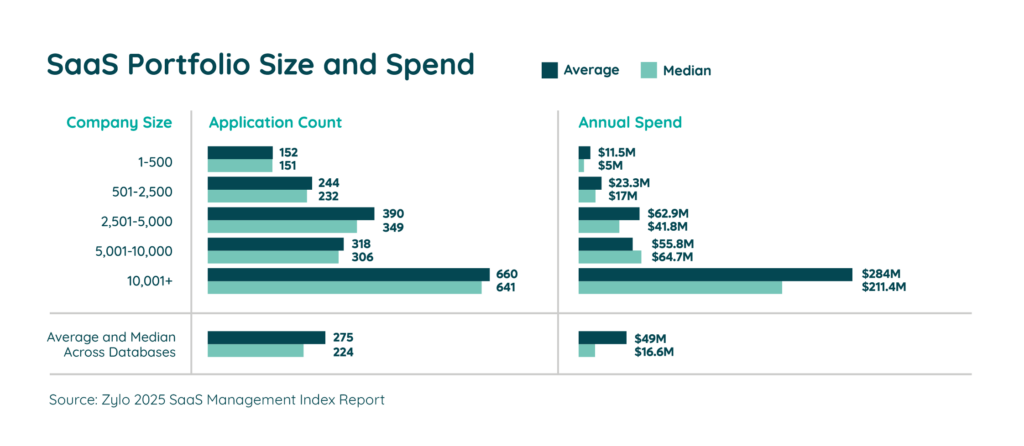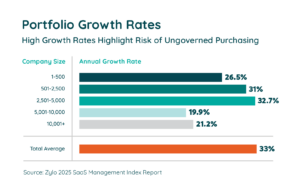Table of Contents
SaaS continues to explode in popularity as organizations cut the cord in favor of cloud-based applications. But companies aren’t just swapping out their on-premise software for SaaS, they’re increasingly rethinking how it impacts their bottom line.
Due to the dynamic nature of SaaS entering and exiting the typical organization, digital spend is shifting from a fixed capital expenditure (CapEx) to an operational expense (OpEx).
According to Gartner, “These trends are broadly illustrated by an increase in the ratio of OpEx in overall IT budgets, from 70% in 2014 to 77% in 2020. About half of IT and financial management leaders report their OpEx versus CapEx ratio significantly increased over the last three years with the use of public cloud.”
Despite causing some friction for CFOs, adopting the mindset of SaaS as an IT OpEx offers some key benefits, such as enhanced agility, cost savings, and scalability. Ultimately, it helps businesses realize the expected value of their SaaS investments.
What’s the Difference Between IT OpEx and CapEx?
Before we dive deeper, let’s take a moment to define both CapEx and OpEx.
CapEx, or capital expenditures, are large purchases an organization makes to serve its long-term needs. Typically paid as a fixed cost, examples of capital expenditures include real estate, vehicles, and machinery. It takes longer to see a return on CapEx, and in many cases these assets depreciate in value over time.
Operating expenses (OpEx) include the day-to-day expenses a company pays to run the business, such as salaries, utilities, and increasingly — software. Operating expenses are often paid for in recurring installments and provide immediate value.
Why Should SaaS Be an IT Operating Expense?
Before the rise of SaaS and cloud software, companies invested heavily in on-premise software that needed to be physically installed in the office. The software was sourced exclusively by IT teams and meant to support the business for several years. It was a predictable investment for the business, so CFOs treated software as a CapEx.

But the cloud changes everything. Zylo data shows the average enterprise organization today maintains more than 660 applications and can see as many as 12 new SaaS tools enter their environment every 30 days. Over the course of a year, this adds up to 22% portfolio growth. Because of this fluidity, it often makes more sense to treat software as an IT operating expense. Take a look at some of the key benefits.

Businesses Need Flexibility and Scalability
By definition, cloud-based software supports the dynamic nature and rapidly changing business environment of today’s hybrid workforce. Rather than waiting for a lengthy install, businesses can launch a new software in minutes with the swipe of a credit card, and just as easily remove or downgrade the tool as needed.
According to Gartner, “Sixty-eight percent of IT and financial management leaders rate use of cloud as important to their digital business initiatives, with the top reason being for the greater agility and flexibility it provides.”
Immediate Cost Savings
In tough times, it’s far easier (and practical) to trim some fat from your IT OpEx versus reducing capital expenditures, where you’d literally need to sell a building or unload some equipment, likely at a depreciated value.
According to Gartner, “Transitioning to OpEx-based digital solutions, like cloud services, results in a new model with lower initial costs that gradually increase over the length of the contract as usage increases and other fees emerge.”
The beauty of SaaS is you gain more control over mitigating software costs. In the past, you might have been locked into a years-long contract for on-premise software or stressed over selling off assets. Today, you can quickly reduce costs by rightsizing underutilized licenses or eliminating redundant or duplicative software altogether.
Additional Value-Based Benefits of IT OpEx
Gartner says CFOs can become more comfortable with the shift by highlighting the benefits and value OpEx provides in terms of achieving the organization’s digital strategy. Beyond cost savings, Gartner mentions the following value-based benefits of shifting digital strategy to an IT operating expense:
- Increased flexibility due to fewer internal technological constraints
- Seamless scalability to keep up with changing times
- Timely access to the latest features and new innovations
- Dedicated support, as well as support networks of other users
Guide to Managing SaaS Costs
Learn MoreMore Flexibility to Protect Budgets
If you keep a watchful eye on your organization’s SaaS costs, you can make real-time decisions to protect other components of your OpEx, such as payroll, marketing spend, or recruiting. Eliminating any of these functions could lead to even larger consequences for your organization.
What About Risks?
Transitioning your digital strategy to an IT operating expense does invite some drawbacks, notably hidden costs and risks. According to Gartner, they might include:
- Unpredictable costs from consumption-based pricing models
- Extra costs from bundled support pricing that remains unused
- Process security risks from potential outages or poor connectivity
However, you can mitigate these risks by deploying an ongoing, programmatic strategy to manage your cloud inventory. A SaaS Management tool like Zylo enables your organizations to discover all SaaS applications (even tools expensed by teams or employees), monitor license utilization in real-time, inform rationalization decisions, and optimize contract renewals and agreements.
Looking ahead, cloud software will continue to overtake on-premise solutions, ultimately becoming the most highly utilized software by the end of the decade. With a shift in mindset, CFOs can enjoy the benefits of leveraging SaaS as an IT OpEx.
Ready to learn more about optimizing your SaaS investment while controlling costs? Grab a copy of Zylo’s Guide to Managing SaaS Costs eBook.

